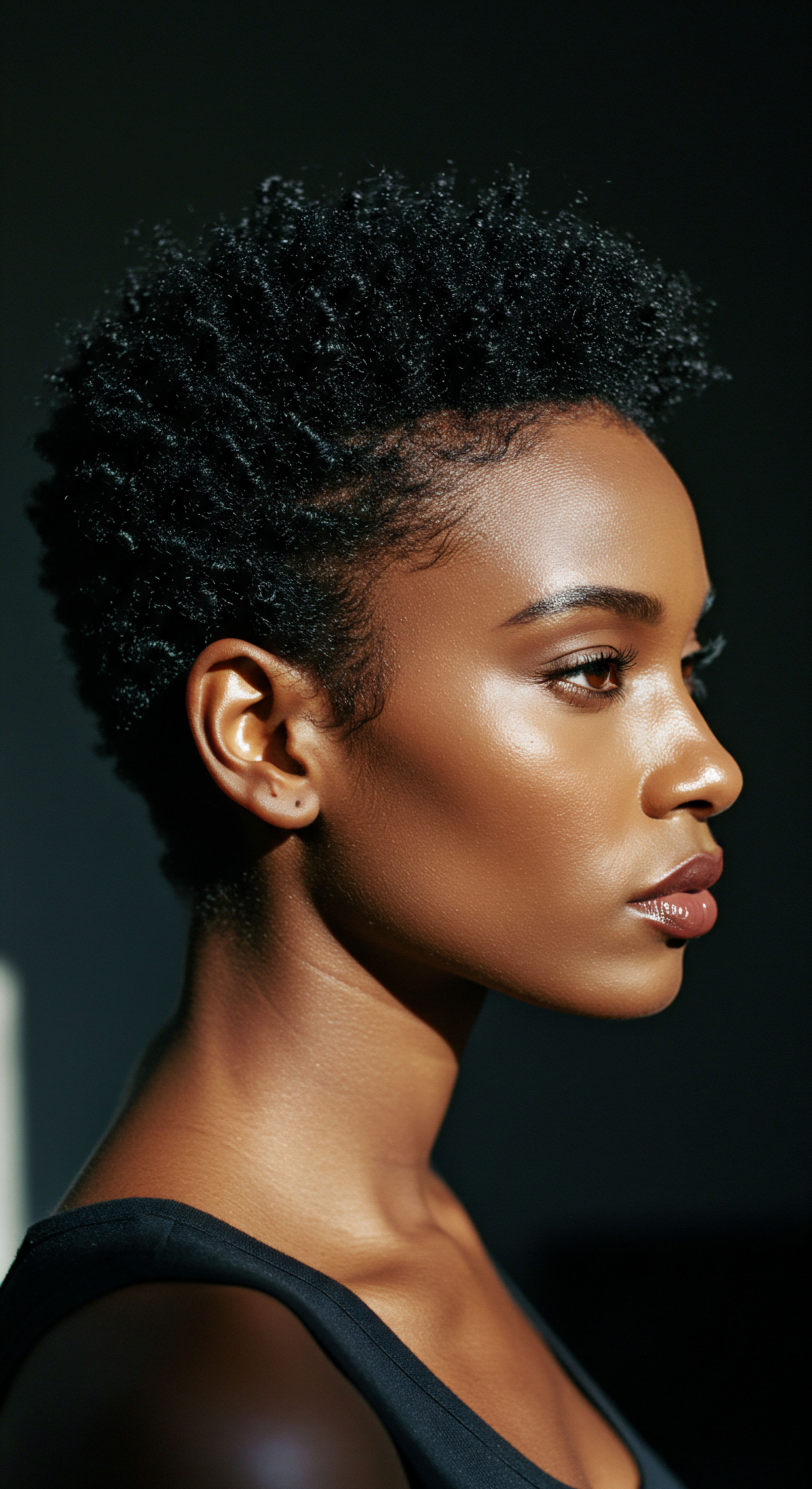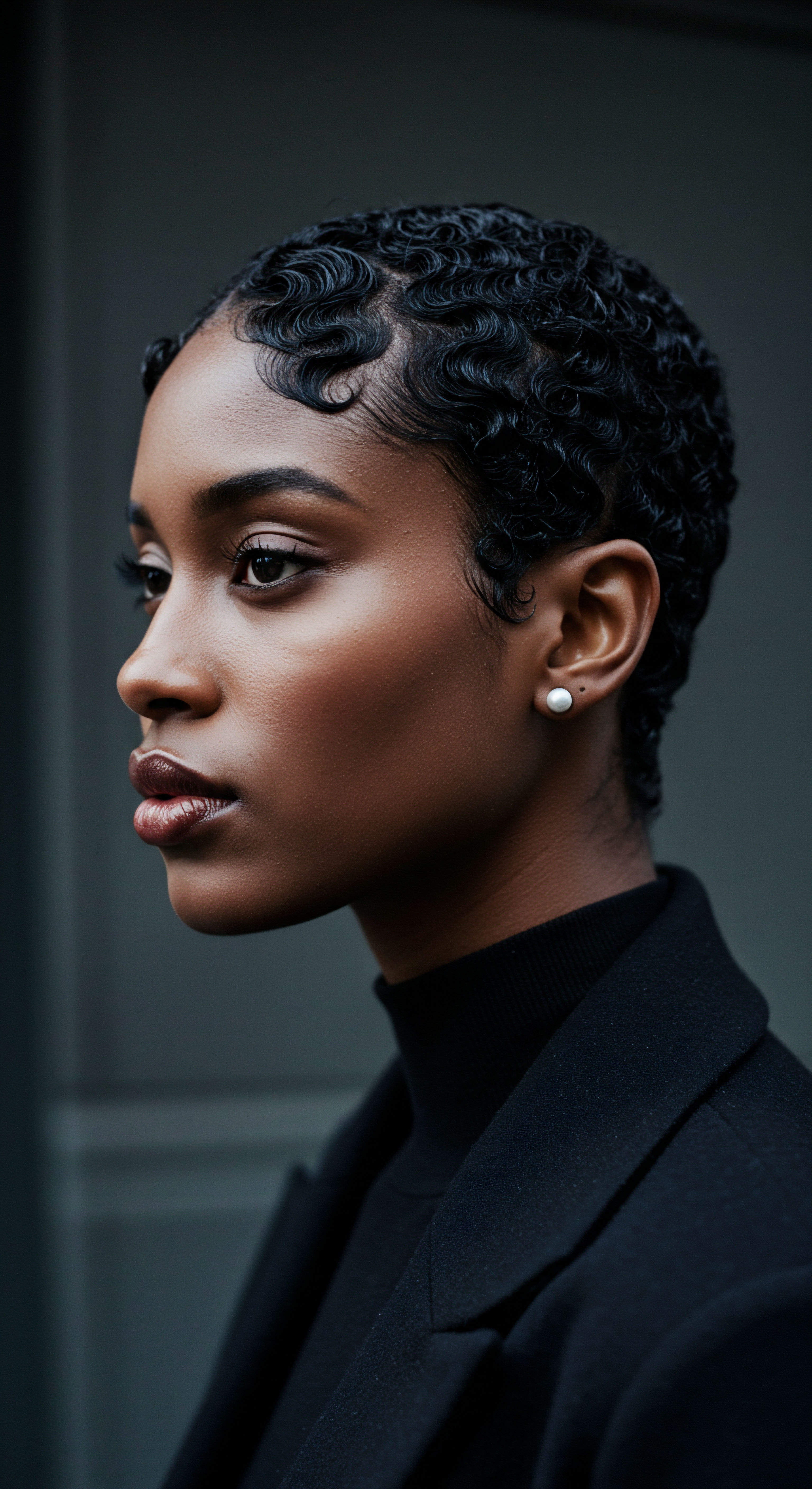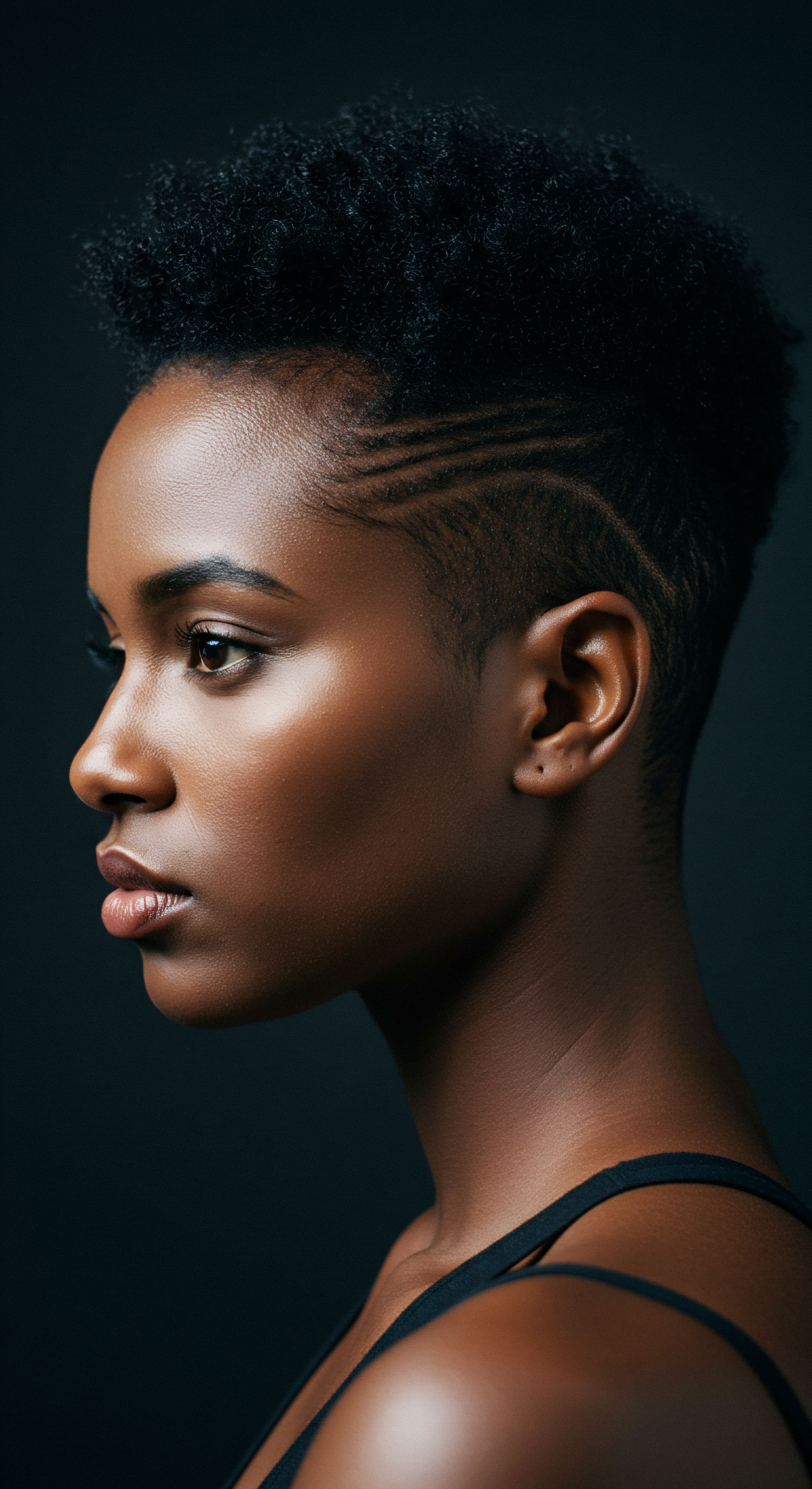
Roots
Consider the quiet hush of nightfall, when the world outside softens its edges, and within our homes, a subtle ritual often takes hold. This practice, the covering of one’s head for sleep, extends far beyond mere habit. It is a custom steeped in centuries of human experience, a testament to our enduring relationship with comfort, protection, and the silent language of our strands.
For those with textured hair, this nightly covering carries an especially profound resonance, linking present-day care to ancient wisdom and the quiet resilience of generations past. We begin our exploration at the very beginnings, tracing the reasons that first led people to seek solace and safety for their crowns as they rested.

Why Did People Cover Their Heads For Sleep in Early Times?
The practice of covering the head during sleep stretches back to epochs before modern heating systems and advanced hair care products. Early human societies faced harsh realities ❉ cold sleeping environments, unhygienic conditions, and the ever-present challenge of preserving one’s physical self, including the hair. Head coverings, in their most rudimentary forms, served as a primary line of defense.
The simple act of wrapping cloth around the head provided a tangible barrier against the chill of night air, a warmth that was not a luxury but a fundamental requirement for survival in dwellings without consistent temperature regulation. This thermal comfort was a universal human need, making the sleep covering a common sight across disparate cultures and climates.
Beyond warmth, rudimentary head coverings offered a degree of protection against external elements that might disrupt sleep or compromise hygiene. Dust, insects, and other environmental factors were constant companions in early homes. A covering could shield the hair and scalp from these intrusions, contributing to a cleaner, more restful slumber. For individuals with longer hair, or hair styled in elaborate ways, a covering also served to maintain order.
Waking with tangled or disheveled hair, especially in societies where hair grooming was a lengthy and significant ritual, would have been highly impractical. The sleep covering thus became a practical tool for minimizing morning hair challenges, allowing individuals to rise with their hair relatively undisturbed.
The practice of covering one’s head for sleep, stretching back centuries, provided early humans with essential warmth and protection from environmental elements.

The Ancient World and Hair Preservation
In ancient civilizations, hair often held immense social, spiritual, and aesthetic significance. Its care was not merely about cleanliness but about identity, status, and connection to the divine. This elevated status of hair naturally extended to its preservation, even during periods of rest. In ancient Egypt, for example, people, including the Kemetic population, used head coverings to keep their varied hairstyles intact and to maintain the benefits of their hair conditioners or greases.
These coverings, often crafted from linen, were not only for practical protection from the desert environment but also to preserve the intricate styles that symbolized status and beauty. The remnants of such coverings found on mummies bear quiet witness to this long-standing practice.
The meticulous nature of ancient hairstyles, which could involve braiding, oiling, and complex arrangements, made nighttime preservation a sensible choice. Disturbing these styles through friction with sleeping surfaces would necessitate extensive re-styling each morning, a time-consuming endeavor. Thus, the sleep covering became an accessory that safeguarded the day’s artistic expression, allowing individuals to awaken with their coiffures largely preserved. This consideration for hair integrity, particularly for textures that might be more prone to tangling or disruption, formed a silent, yet powerful, reason for the adoption of sleep coverings.
| Historical Era Pre-Heating Eras |
| Primary Purpose Thermal Comfort |
| Materials Commonly Used Cotton, Wool, Linen |
| Historical Era Ancient Civilizations |
| Primary Purpose Hair Preservation, Hygiene |
| Materials Commonly Used Linen, Simple Fabrics |
| Historical Era 18th Century Europe |
| Primary Purpose Wig Protection, Warmth |
| Materials Commonly Used Silk, Fine Cloth |
| Historical Era These early uses laid the groundwork for modern hair protection. |

Ritual
Stepping from the quiet beginnings of necessity, we move into the realm where head coverings for sleep transformed into a cherished ritual, a practice infused with practical wisdom and a deep respect for hair’s well-being. This shift acknowledges not just the need for warmth or cleanliness, but a growing understanding of how delicate strands respond to nightly friction and environmental factors. For those with textured hair, this transformation was particularly meaningful, as specific hair structures presented unique challenges that coverings could mitigate. The nightly ritual became a gentle act of preservation, a silent conversation between self and strands.

How Did Sleep Coverings Protect Hair From Damage?
As societies progressed, so did the understanding of hair’s physical properties. The advent of smoother fabrics, such as silk and satin, brought a new dimension to sleep coverings. Unlike rougher materials like cotton, which can absorb hair’s natural moisture and create friction, silk and satin provide a smooth surface that allows hair to glide freely. This reduced friction is paramount in preventing tangles, frizz, and breakage, particularly for textured hair, which, with its unique curl patterns and cuticle structure, is more susceptible to mechanical damage.
A study on the frictional properties of human hair fibers highlights how different textile surfaces interact with hair. Research indicates that certain fabrics, like cotton, exhibit a higher coefficient of friction when sliding against hair strands compared to smoother materials such as silk or satin. This heightened friction, repeated over a night of tossing and turning, can lead to the lifting and abrasion of the hair’s outer cuticle layer, resulting in increased porosity, moisture loss, and ultimately, breakage.
For textured hair, where the cuticle layers are already more exposed at the bends of the curls, this friction is particularly detrimental. By interposing a smooth barrier between hair and sleeping surface, coverings made of silk or satin act as a shield, preserving the hair’s integrity and natural moisture content.
- Reduced Friction ❉ Silk and satin materials minimize the rubbing between hair and pillowcases, preventing mechanical stress.
- Moisture Retention ❉ Unlike absorbent cotton, smooth fabrics allow hair to retain its natural oils and applied products, combating dryness.
- Style Preservation ❉ Keeping hair contained within a covering helps maintain styled looks, reducing the need for daily manipulation.

The Evolution of Sleep Caps and Bonnets
The form of sleep coverings evolved over centuries, adapting to changing hair styles and societal needs. In the Victorian and Edwardian eras, nightcaps were common, initially serving primarily for warmth in unheated bedrooms. These were often simple, practical caps made of cotton or wool. However, as elaborate hairstyles became fashionable, especially those achieved through methods like Marcel waving, the purpose of the nightcap broadened to include style preservation.
Silk nightcaps became popular, valued for their ability to keep hair tangle-free and even impart a glossy appearance. Women would wear these bonnets to protect their curls and prevent deformation of their coiffures during sleep. The shift towards satin in the late 19th century further underscored the desire for materials that were less rough on the hair, allowing it to move freely and reducing the need for extensive morning combing.
For individuals with textured hair, the bonnet, or sleep cap, has a particularly rich and enduring history. In the African American community, the use of silk hair wraps and bonnets became, and remains, a practice to protect natural hairstyles and maintain hair health. This is a tradition passed down through generations, a silent understanding of how to care for delicate strands and preserve moisture. The design of these coverings, often featuring a secure yet gentle elastic band, ensures they stay in place throughout the night, providing continuous protection for diverse hair types, from coils to braids.
The shift to smoother materials for sleep coverings, like silk and satin, marked a recognition of their ability to significantly reduce hair friction and maintain moisture.
| Fabric Type Cotton |
| Friction Level High |
| Impact on Hair Increased tangling, frizz, breakage, moisture loss |
| Fabric Type Polyester Satin |
| Friction Level Moderate |
| Impact on Hair Better than cotton, but can still generate static |
| Fabric Type Silk |
| Friction Level Lowest |
| Impact on Hair Minimizes friction, preserves moisture, reduces breakage |
| Fabric Type Smooth fabrics offer superior protection against hair damage during sleep. |

Relay
Our exploration now turns to the deeper currents that carried the practice of head coverings for sleep through time, connecting practical application with profound cultural meaning and scientific understanding. This section peels back the layers, revealing how these coverings became symbols of identity, resistance, and self-care, particularly within communities with textured hair. It is here that the intersection of tradition, biology, and social history truly comes to light, offering a comprehensive understanding of this seemingly simple act.

What Cultural Meanings Do Sleep Coverings Hold?
Beyond their functional benefits, head coverings for sleep carry significant cultural weight, particularly within communities of the African diaspora. What began as practical protection evolved into symbols of identity, modesty, and resilience. In many African cultures, headwraps, known by names such as “dukus” in Ghana and Namibia or “geles” in Nigeria, have been traditional attire for centuries, communicating social status, marital standing, and even emotional states.
While not exclusively for sleep, the principle of covering the hair for its preservation and presentation extended into nighttime routines. These coverings served to shield hair from environmental elements and maintain intricate styles, reflecting a deep respect for one’s appearance and heritage.
The historical trajectory of head coverings for Black women in the Americas is particularly complex. During the era of enslavement, headwraps were sometimes weaponized, imposed as a visual marker to distinguish enslaved women and signify their subjugated status. Laws in certain regions, such as the 1784 “Edict of Good Government” in Louisiana, mandated that Black women wear their hair bound in a kerchief or “tignon,” ostensibly to control their perceived sensuality and exoticism. Despite this oppressive intent, Black women reclaimed these coverings, transforming them into symbols of resistance, dignity, and cultural pride.
They used the folds and styles of their headscarves to communicate coded messages, covertly exchanging information beyond the grasp of their enslavers. This powerful act of redefinition solidified the headwrap’s place as a cultural artifact of defiance and self-assertion, a legacy that extends to modern-day sleep bonnets and scarves.
Head coverings for sleep carry deep cultural meaning, particularly for Black women, symbolizing identity, resilience, and a connection to ancestral practices.

How Does Hair Biology Support Nighttime Protection?
The science behind why textured hair benefits so significantly from nighttime coverings is rooted in its unique structural characteristics. Textured hair, whether curly, coily, or kinky, possesses an elliptical cross-section and a cuticle layer that is more prone to lifting at the hair’s many bends and twists. This structural reality makes it inherently more susceptible to mechanical damage from friction. When hair rubs against a rough surface, such as a cotton pillowcase, the delicate cuticle scales can lift, chip, or even break away, leading to frizz, dryness, and ultimately, breakage.
Consider the data from a study on the frictional properties of hair ❉ research from TRI Princeton demonstrated that certain materials, like cotton, cause significantly more friction on hair strands compared to smoother options like silk. For instance, studies have indicated that cotton can increase hair breakage by a notable percentage compared to smoother fabrics. This phenomenon is especially pronounced for textured hair, which already experiences higher friction coefficients due to its natural configuration. The constant rubbing against an absorbent, high-friction surface also strips hair of its vital moisture and natural oils, leaving it dry and brittle.
A sleep covering, particularly one made of silk or satin, creates a low-friction environment, allowing the hair to glide rather than snag, thereby preserving the cuticle layer, retaining moisture, and extending the life of hairstyles. This scientific understanding validates the generations-old practice of covering textured hair for sleep, transforming anecdotal wisdom into demonstrable biological benefit.
- Hair Porosity ❉ Textured hair often has higher porosity, making it lose moisture more readily to absorbent fabrics like cotton.
- Curl Pattern Integrity ❉ Maintaining curl definition and preventing matting requires a smooth surface that does not disrupt the hair’s natural coils.
- Reduced Breakage ❉ The minimized friction from silk or satin directly reduces the physical stress that leads to hair strand fracture.

What Modern Science Says About Hair and Friction?
Modern trichological research continues to affirm the wisdom of sleep coverings. The understanding of hair mechanics at a microscopic level has advanced, allowing scientists to quantify the damage caused by friction. Techniques using frictional force microscopes (FFM) allow for nano-level examination of the outermost cuticle layer of hair, revealing how environmental stimuli and mechanical stress alter its surface structure. When hair, especially hair with a more complex structure, experiences constant rubbing, these microscopic changes accumulate, leading to visible damage.
The protective barrier offered by a sleep covering, therefore, is not merely anecdotal comfort but a scientifically sound strategy for preserving hair health and reducing the need for extensive morning manipulation. This contemporary validation solidifies the historical and cultural practices as not just traditions, but as acts of informed care.
| Cultural Context African Cultures |
| Symbolic Meaning Status, Marital State, Identity |
| Historical Period Centuries ago to present |
| Cultural Context African American Community |
| Symbolic Meaning Resistance, Dignity, Self-Care |
| Historical Period Slavery era to present |
| Cultural Context Religious Practices |
| Symbolic Meaning Modesty, Faith, Respect |
| Historical Period Ancient times to present |
| Cultural Context Head coverings carry layers of meaning beyond simple function. |

Reflection
The quiet act of covering one’s hair for sleep, a seemingly simple gesture, unfolds into a rich historical narrative. It is a story told through the evolving needs of human comfort, the intricate science of hair biology, and the deep cultural currents that shape our daily practices. From ancient necessity to modern understanding, this tradition persists, not as a relic of the past, but as a living testament to human ingenuity and a continuous quest for well-being.
For those with textured hair, the sleep covering is a tangible link to resilience, a symbol of care passed down through generations, and a quiet affirmation of beauty preserved through the night. It reminds us that sometimes, the most profound wisdom resides in the gentle, consistent acts of self-care.

References
- Prasad, G. V. K. P. Agrawal, R. K. & Bhardwaj, B. P. (2016). Study on Frictional Properties of Human Hair Fibers. Journal of Textile Science & Engineering, 6(1).
- Robbins, C. R. (2012). Chemical and physical behavior of human hair. Springer Science & Business Media.
- Bhushan, B. Trinh, L. & Chen, N. (2014). Friction Dynamics of Straight, Curly, and Wavy Hair .
- Schwartz, A. M. & Knowles, D. (1963). Frictional Effects in Human Hair. Journal of the Society of Cosmetic Chemists, 14(2), 67–73.
- El-Messiry, M. Ibrahim, S. & Youssef, H. (2017). Friction Coefficient and Electric Static Charge of Head Scarf Textiles. EKB Journal Management System.
- Myers, J. C. & Russell, C. B. (1998). The physical properties of human hair ❉ Effects of environmental factors and mechanical manipulation .
- Johnson, D. A. (2021). Sleep health disparities and their impact on chronic diseases. Emory University.
- Goody, J. (1997). Representations and Reality ❉ Essays on the Anthropology of Historical Sources. Cambridge University Press.
- Byrd, A. (2001). Hair Story ❉ Untangling the Roots of Black Hair in America. St. Martin’s Press.